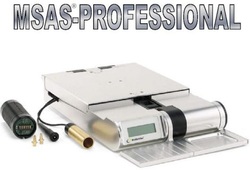BioMeridian MSAS-Pro Review

When I began doing Sensitivity Elimination Treatment I tested patients using a leg-length check.
It went like this: the patient would lie prone and I’d check to see which leg was shorter than the other (there is always a short leg). Once that baseline was established, I would place a testing vial in their hand and observe the leg length again. If the short leg became shorter, meaning the patient’s body didn’t like what was in the vial, I would perform the treatment. If the legs didn’t even out, I’d repeat the treatment.
There’s more to how inefficiently my treatment was back then, but I’m sure you can already see that doing things manual … is … so … slow. You’re also limited to what you can test and treat for by the number of testing vials you own. And testing vials are expensive. Lastly, you can’t be very specific when you’re using pre-loaded testing vials.
What I mean is, if a patient reacted to a vial called TREE POLLENS, that vial might have 200-300 different pollen samples in it. What if they’re sensitive to only 50? You’re stuck having to treat for the whole vial, and in my opinion that significantly weakens the effectiveness of the treatment. The more specific the treatment is the better it is.
In those days it was common to have to treat many vials multiple times over multiple visits.
Then, in 1999, I met a representative from BioMeridian who was demonstrating the MSAS-Professional. (I believe BioMeridian is now Integrative Health Technologies.) I purchased one on a lease-to-own program.
(These impressions are for the machine I bought back in 1999. I’m sure IHT has improved the hardware and software since then.)
It went like this: the patient would lie prone and I’d check to see which leg was shorter than the other (there is always a short leg). Once that baseline was established, I would place a testing vial in their hand and observe the leg length again. If the short leg became shorter, meaning the patient’s body didn’t like what was in the vial, I would perform the treatment. If the legs didn’t even out, I’d repeat the treatment.
There’s more to how inefficiently my treatment was back then, but I’m sure you can already see that doing things manual … is … so … slow. You’re also limited to what you can test and treat for by the number of testing vials you own. And testing vials are expensive. Lastly, you can’t be very specific when you’re using pre-loaded testing vials.
What I mean is, if a patient reacted to a vial called TREE POLLENS, that vial might have 200-300 different pollen samples in it. What if they’re sensitive to only 50? You’re stuck having to treat for the whole vial, and in my opinion that significantly weakens the effectiveness of the treatment. The more specific the treatment is the better it is.
In those days it was common to have to treat many vials multiple times over multiple visits.
Then, in 1999, I met a representative from BioMeridian who was demonstrating the MSAS-Professional. (I believe BioMeridian is now Integrative Health Technologies.) I purchased one on a lease-to-own program.
(These impressions are for the machine I bought back in 1999. I’m sure IHT has improved the hardware and software since then.)
What I liked about the MSAS-Pro
- The beauty of the MSAS-Pro was that it had a database of many thousands of potential stressors. I was no longer limited to pre-made vials.
- I could make a treatment vial that held only what I wanted to treat my patient for. That made the treatments so much more effective.
- Most people think computerized processes are better. Sometimes they’re not, but that’s the impression they give. Having computer-aided testing made my practice look more professional and high tech.
- It had a sensitivity-testing mode. (ZYTO's software doesn’t.)
What I didn’t like about the MSAS-Pro
- The hardware made a very annoying noise. I eventually got used to it but the doctor I shared an office with never did. I had to listen to the noise for what they called an indicator drop. An indicator drop meant the patient was sensitive to the item they were being tested for.
- The probe is intimidating to children. They think they’re going to get jabbed by something sharp.
- There were a lot of false positives. I won’t bore you with the details but this was extremely frustrating and a huge time waster.
- It took 3-7 seconds to test each stressor. Longer if they reacted to something because I had to move my hands to the keyboard and press a key combination. This resulted in office visits that typically ran 15-20 minutes, sometimes as long as 30 minutes. The visits were so long I had a few patients fall asleep while I was testing them.
- It was hard on my back because I had to hunch over their hand.
- The machine was battery powered. The tiny wires connected to the battery terminals eventually cracked and broke.
- Reading items into the computer required using different hardware and software. They came with the system but it was annoying to have to exit the main software, read the items into the database, then restart the program. This is integrated in ZYTO’s software (although items read into the software are only saved in that visit, not in the library).
I appreciated having the MSAS-Pro at the time because it was far better than doing things manually and I could help more people in more ways. But when the ZYTO Elite came along, the MSAS-Pro went into a box in the closet, never to see the light of day again.